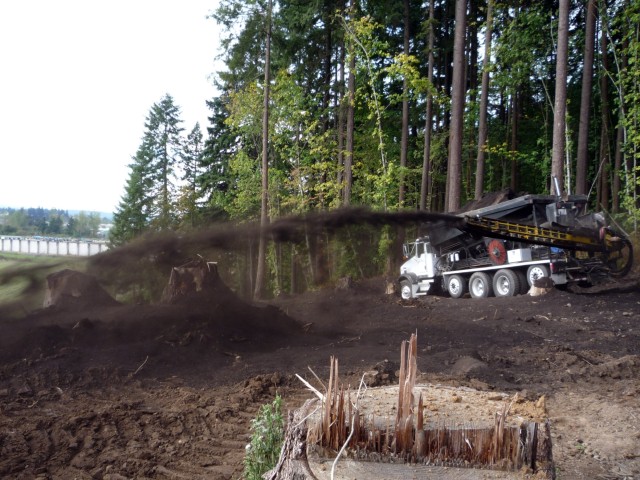ABERDEEN PROVING GROUND, Md. -- The Oregon Army National Guard's Camp Withycombe won the FY 2009 Secretary of the Army award for environmental restoration efforts on an installation.
Camp Withycombe completed the remediation of six former training ranges in preparation for a major Oregon Department of Transportation highway development project. The use of green remediation technologies at Oregon Army National Guard's largest ever restoration project earned them recognition in the Army's environmental awards program.
In preparation for freeway construction starting in 2012, Camp Withycombe is working to clean up the proposed highway corridor and transfer the land to the state. The area to be transferred includes six former training ranges. Though closed for live-fire training in the 1990s, the former ranges accumulated lead bullets during their use for approximately 100 years.
With freeway construction set to begin, the National Guard immediately began planning to design a sustainable cleanup for completion by 2011 that would use green remediation technologies.
If Camp Withycombe had used a traditional approach to site cleanup, more than 30,000 tons of contaminated soil would have been excavated and hauled by dump trucks to a hazardous waste landfill 120 miles away from the site on highways that pass through a national scenic area. This solution would have cost approximately $11 million with excavation, disposal and transport costs, and would have produced high levels of emissions (due to transport). By contrast, the green remediation soil treatment system was implemented at a cost of $5.9 million, a cost avoidance of more than $5 million.
This green treatment system remediated more than 30,000 tons of soil using dry particle separation and a wet gravity separation process to remove bullets and fragments using gold mining equipment. The contaminated soil was delivered by conveyor belt to a wet screening machine, where the soil was separated through sifting into various sizes. Inside the machine, the soil was sprayed with a high pressure blast of water to break down the soil clods. Soil was then treated and reclaimed. More than 50 percent of the soil was cleaned and ready to be used in reforestation to refill a mountain.
Nearly 300 tons, or approximately 25,205,000 bullets, were sifted out and reclaimed for recycling. Revenue generated by lead recycling was reinvested into restoration.
The soil treatment system used a closed loop water system that filtered and recycled its own water, reducing demand and preventing the discharge of contaminated water. The system also boasted a storm water collection component, which collected and directed it into the closed loop system as process water. Upon completion of soil washing, the system treated the process water so it could be recycled for irrigation during natural resources restoration.
An independent panel of judges made up of professionals from federal, state and Army organizations recommended ORANRG for the award. The Secretary of the Army Environmental Awards represent the highest honor in the field of environmental science and sustainability conferred by the Army, and the Camp Withycombe will go on to compete in their category at the Secretary of Defense Environmental Awards later this year.
"The Oregon Army National Guard has successfully blended an efficient and innovative environmental restoration program with a concurrent emphasis on principles of sustainability, green remediation and mission support," said Ray Fatz, President and CEO, Plexus Scientific Corp and Secretary of the Army Awards Judge. "The techniques used are of particular value to the Army and Department of Defense environmental restoration programs in that they are simple in approach and directly transferable to other sites undergoing range cleanup of small arms ammunition."
Deputy Assistant Secretary of the Army for the Environment, Safety and Occupational Health Tad Davis recognized Camp Withycombe and the winners of the other eight categories as the best examples of how environmental stewardship and sustainability play a crucial role in the Army's mission readiness.
"The Army recognizes successes that demonstrate mission-driven solutions that protect the environment at installations here and overseas. Whatever we do needs to revolve around supporting the mission, taking care of our Soldiers, civilians, and Families," said Davis. "In simplistic terms the Army, our Army, your Army - is building green, buying green and going green. These winning environmental programs make the Army sustainable thereby impacting generations to come."
For details about the Secretary of the Army Environmental Award recipients, visit the U.S. Army Environmental Command's Web site at http://aec.army.mil/usaec/newsroom/awards00.html.








Social Sharing